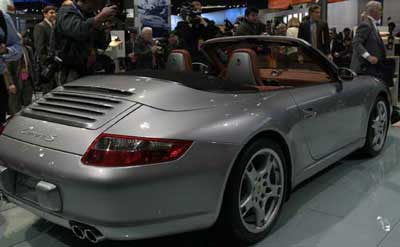Recent Articles
Popular Makes
Body Types
2006 Dodge Charger, Honda Ridgeline, more debut at Detroit Show
2005 North American International Auto Show unveils newest models
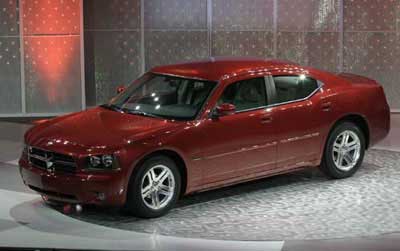
DETROIT, Mich - Watch out, Baby Boomers. After a day spent talking about the future and dreaming about what could be if only they really could build and sell a Jeep with two Hemis, automakers at the 2005 North American International Auto Show debuted real live cars -- the kind you can buy - and did so with a decidedly boomer-ish feel. "Older people want to buy a younger feeling car," said Jim Press, Toyota Motor Sales executive vice president and COO. "They don't want to buy a car that makes them feel old. We're seeing the market shift. Baby boomers are looking for SUV feeling with sedan performance." At the time, Press was talking about Toyota's new concept, the FT-SX, which demonstrates an ideal crossover - SUV ride height and space, with sedan-like looks and performance. But the same applies for Toyota's production debut at the 2005 North American Auto Show, the 2006 Toyota Avalon. This thorough revamping of a longtime favorite in the Toyota lineup is directly aimed at pleasing the baby boomer market, with loads of features and a more stylish exterior. Dodge is doing the same thing with the 2006 Charger, though they've added in a healthy dollop of nostalgia with the latest vehicle to come off of Chrysler's successful rear drive platform. This is the same platform on which the Chrysler 300/300C and Dodge Magnum are built. Dodge executives hope that the Charger awakens the baby boomers to wistful memories of drag racing down Main Street in the original, two-door version. Even the luxury brands were aiming at the heart of the I-have-money-the-kids-are-out crowd, with a new Porsche 911 cabriolet, a more muscular BMW 5 Series and Infiniti M. The lone exception to the baby boomer rule, at least after the first spate of unveils, was the Hyundai Sonata - a nifty new sedan that may well throw a scare into the Honda Accord and the Toyota Camry. Automakers are also showing that the sedan and coupe renaissance is not over, as cars dominated the show, and new SUVs were hard to find. By Brian Chee Photos by Erik Hanson
2006 BMW 5-Series
A rolling stone gathers no moss. Trite, but true, especially when it comes to BMW. Just two years after launching the redesigned BMW 5-Series, Germany's purveyor of ultimate driving machines debuted new inline six-cylinder engines, a new all-wheel-drive system, and a new station wagon variant of the 5-Series at the 2005 North American International Auto Show in Detroit. BMW's new family of inline six-cylinder engines supply more power, greater efficiency, and lower mass than ever before. BMW 525i models receive a new 218-horsepower, 2.5-liter inline six that cranks out 184 lb.-ft. of torque between 2,750 and 4,250 rpm. BMW 530i models get a 258-horse motor displacing 3.0 liters and developing 221 lb.-ft. of torque between 2,500 and 4,000 rpm. Thanks to engine blocks constructed of aluminum and magnesium, these new engines are also lighter than before, helping to reduce curb weight. In fact, BMW claims that they are the lightest vehicles in their class. The new all-wheel-drive system that BMW is offering on both the 525xi and 530xi sedans and on the 530xi Touring wagon is an adaptation of the xDrive technology currently installed in the X3 and X5 sport-utes. BMW claims that xDrive is unlike any other all-wheel-drive system on the market because it redistributes engine power before the wheels begin to spin to foster traction, stability and agility. We've had the chance to try several X3 and X5 models equipped with xDrive, and the system does react quickly. Wagon variants are sold only as the 530xi Touring, meaning that they come standard with xDrive and the new 258-horsepower engine. Other goodies include Hill Descent Control, which automatically limits vehicle speed when traveling down steep and slippery hills, and adaptive headlights, which swivel with the steering to help illuminate around curves. A panoramic sunroof and a head-up display are also BMW 530xi hallmarks. Wider, longer, and taller than the 5-Series sedan, the new 5-Series Touring wagon adds a significant amount of cargo toting capability, able to schlep up to 56.5 cubic feet of stuff with the rear seat folded down. luxury car buyers always want the latest and greatest gadgets. With the new six-cylinder engines, xDrive all-wheel-drive, and Touring model that have been added to the 5-Series lineup for 2006, BMW clearly understands the mindset of the wealthy American consumer. By Christian J. Wardlaw Photos by Erik Hanson
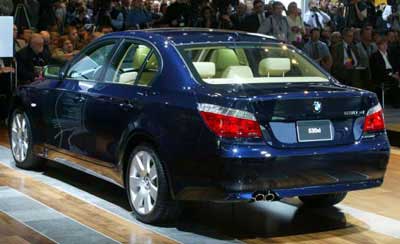
2006 Dodge Charger
The King was in the house. And though more than a few present at the Dodge Charger event during the 2005 North American International Auto Show remember why it is that he's called the King, Richard Petty nonetheless struck an imposing figure, complete with cowboy hat and sunglasses. This is America, man -- then and now - and NASCAR Dads from Toledo to Temecula will remind you of that fact. It's these same Dads - and a bit older - that Dodge is hoping to reach with its new 2006 Dodge Charger. To underscore the point, the Dodge Charger will compete in the Nextel Cup series this year. It will succeed the Dodge Intrepid nameplate of old. On the track and on the street, the Charger is sure to make an impression. Red as a Magnum and complete with a load of Dale Jr. attitude, the 2006 Dodge Charger is one heck of a load of car. Dodge is not taking chances with this one, even giving it a nostalgic name that really, truly doesn't fit. The original Charger, after all, was not nearly as attractive and even had two gorgeous wings, whereas the new Charger sports four little doors. The original had that long snout -- and this one, well, looks suspiciously like the nose currently adorning the Dodge Magnum. Ah. But wait. That there 2006 Dodge Charger is a "four door coupe," meaning that it looks like a coupe but is really a sedan. That's a bit like calling a horse a tall, non-milk-producing MENSA cow. Marketing-speak aside, however, this is one heck of a car. The interior is almost exactly like the 300/300C interior and Magnum, meaning that it's well engineered, will wear well and offers plenty of front and rear room. This is a big car, after all, with a large trunk and miles of legroom. Even with the V6 engine, the Charger should carry some freight on the road - so small MINIs and compacts beware. Like the Chrysler 300/300C, the Charger features a 250-horsepower V-6 engine or a 340-horsepower Hemi engine, connected to 18-inch rear wheels powered by the famed Chrysler rear wheel drive platform. Chrysler executives claim that it boasts a "near" 50/50 weight distribution. Technology on the Charger is also the same as the Chrysler 300/300C, with a Multiple Displacement System (MDS) that deactivates four cylinders when needed. Chrysler people claim that this system saves up to 20 percent in fuel economy, a savings sure to be gobbled up by bright-eyed Boomers and NASCAR Dads, striving hard to lay down a nice patch for the King. The 2006 Dodge Charger will be available this summer. Pricing has not yet been announced. By Brian Chee Photos by Erik Hanson
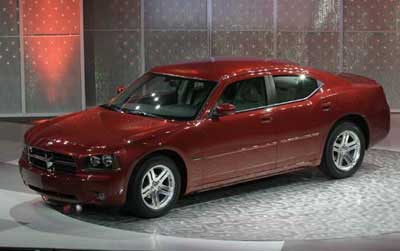
2005 Honda Ridgeline
Well, it won't sing a song for you. That much we know. And it probably will not load up your plywood or shovel in your mulch. But other than that, Honda's 2005 Ridgeline will do things that trucks really ought not do. Like have a trunk. Debuted at the 2005 North American International Auto Show, the Ridgeline uses innovation like a scalpel to carve out a niche between more robust mid-size trucks, crossovers and Subs. Honda's first truck is likely to surprise quite a few cranky truck shoppers with its features, to be sure. Depending on its success, one never knows when Honda engineers might take out a slide rule and figure out how to build a V8. Then they would be in Big Truck territory - and there would indeed be trouble in the Motor City. The truck features an independent rear suspension, which enables much of its unique features but also limits its towing capacity to 5,000 lbs. According to James Keller, chief engineer of automotive design, that amount of towing capability should be satisfactory for people likely to buy the 2005 Ridgeline. The Ridgeline is built on a new light truck platform - the same one that will be used to produce the Acura RD-X, though Honda executive Dick Colliver claims that he Ridgeline will be 93 percent exclusive. Features of the Ridgeline include that famous trunk - located under the bed and lockable; a lift gate that also swings out as well as down, much in the manner of a door, and best in class fuel economy. The Ridgeline will be powered by Honda's 3.5-liter v-tech engine that produces 255 horsepower. The bed features a completely flat surface, so large, flat items like sheets of plywood can be moved easily. The bed is made from a sturdy polymer resin. The back of the four-door truck features seats that tilt up, thus creating more cargo room inside the cab. The Ridgeline will be available in March. Pricing should be in the mid-to-upper $20,000 range. By Brian Chee
Photos by Erik Hanson
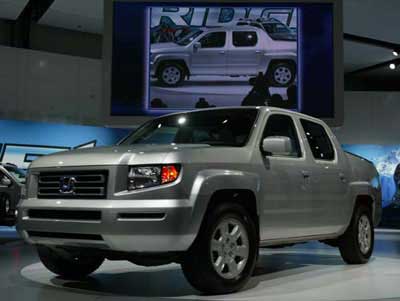
2006 Hyundai Sonata
Hyundai is growing up, and getting bold. You can see it in the confidence with which they talk about their vehicles; the way executives smile when they think about debuting seven new models during the next two years. Perhaps the confidence comes from knowing you have a can’t miss car on the way. If so, Hyundai executives are smiling today, and the car they’re smiling about is the 2006 Sonata. Here, at first blush, is a car that goes squarely to purpose and subtlety of style, a car made to be bought on the merits of driving it, rather than the subjective wind talk of value. Value is, after all, a personal thing. Introduced at the 2005 North American International Auto Show, the Hyundai Sonata looks as if it just may be subtle enough to do battle with the Honda Accord and Toyota Camry. Subtly is important: often the subtle difference between cars is what creates the yawning gulf between winners and losers, between what you buy and the cars you mock. To that end, the true test for the Sonata will be the drive, how the car rattles and hums around corners, and whether the interior feels rich and comfortable or fuzzy and cheap. Judging from the show stage, the Sonata may well have the grown-up style to get noticed. It seems certain to impress buyers with features such as standard side curtain airbags, a roomy interior and a price that will come in under $20,000. Make that well under $20,000, at least according to Robert Cosmai, president and CEO of Hyundai Motor America. Though Cosmai clearly relishes the idea of a low price, he spent most of his time talking about the car and the way it is to be built. Here is a man who has every expectation that a quality car will be built by the good folk in Montgomery, Alabama. For that price under $20,000 – make that well under -- buyers will get six standard airbags and a choice of engines: a 2.4-liter inline four-cylinder engine, rated at 160 horsepower and a 3.3-liter V6 engine making more than 220 horsepower. Both engines are new. Buyers will have their choice between a five-speed manual and a four-speed Shiftronic automatic. The Sonata also includes standard Electronic Stability Control (ESC), Traction Control System (TCS), and standard ABS with Electronic Brake Force Distribution (EBD). It’s a good thing that the Sonata has so many safety features – it sure seems like a lot of car to stop. With 120 cubic feet more room inside than many competitors, the 2006 Sonata is two inches longer, two inches taller, and features a one-inch longer wheelbase. Yep, it’s a big car that doesn't look that big, for a company that’s growing bigger every day. By Brian Chee
Photos by Erik Hanson
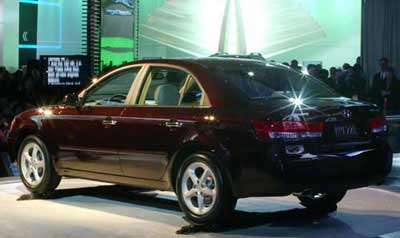
2006 Infiniti M
A great personality doesn't mean squat if you're unattractive. The previous Infiniti M suffered from just such a malady. That car had a lot going for it, but it was cloaked in a wrapper that drew little attention, which amounted to dismal sales of the Infiniti M. With the debut of the M45 Concept in New York last year, Infiniti showed that it had learned its lesson - provide a car that looks as good as it drives. And with the launch of the production version of the M35/M45 at the 2005 North American International Auto Show, Infiniti officials let it be known that the theme of this M is inspire, illuminate, and engage. That attitude, coupled with the new M's bigger-G35 looks will surely open some eyes. Five models will be offered for 2006: M35; M35 Sport; M35 All-Wheel-Drive; M45; and the M45 Sport. Prices range from $39,900 for the M35 and $49,550 for the M45 Sport (excludes destination). Based on a more rigid next-generation front-midship (FM) platform that positions engine weight behind the front axle for improved handling balance, the new 2006 Infiniti M will be available in two flavors: the M35 with a 280-horsepower, 3.5-liter V6 and the M45 with a 335-horsepower, 4.5-liter V8; both fired with push-start control through a standard Infiniti Intelligent Key system and both requiring premium unleaded fuel. Power flows through a five-speed automatic transmission with a short-throw manual shift feature to 18-inch rear wheels, and the M35x model features all-wheel-drive. Buy the M35 Sport or the M45 Sport and you'll get a Rear Active Steer system that adjusts the geometry of the rear suspension according to steering input and vehicle speed, as well as 19-inch lightweight wheels wearing 245/40 performance tires. Run-flat tires and chrome-finish wheels are optional on non-Sport models, and just in case the driver exceeds the limits of talent a standard Vehicle Dynamic Control (VDC) stability control system is on alert to make course corrections. Chock full of the features that most people expect in a luxury car of this caliber, standard equipment includes Bluetooth wireless communications. Options such as a rear DVD-based entertainment system and a RearView Monitor with wheel trajectory pathing are available. However, on the technology front, the 2006 Infiniti M is particularly notable for its optional Lane Departure Warning (LDW) system. This technology reads lane markings and warns the driver if unintended lane drift is detected. To keep occupants even safer, the Infiniti M includes a tire pressure monitor as well as an Advanced Airbag System (AABS) of dual-stage front airbags with occupant classification and side-curtain airbags. Pre-crash front seatbelts that can sense an impending collision and prepare the restraints for impact are optional. Additional techie bits and pieces include standard voice recognition technology for a number of interior features, an optional intelligent cruise control designed to maintain a safe distance behind the car ahead, and HID headlights that swivel with the steering to help illuminate around curves (standard on Sport models; optional on others). Genuine Rosewood or aluminum trim, combined with leather upholstery, outfit the Infiniti M's cabin, which also includes an electrofluorescent "solar eclipse" gauge cluster and a sound system with in-dash CD changer and MP3 playback capability. An impressive Bose Studio Surround audio system with 14 speakers, including two mounted inside the front seats, is optional. The 2006 Infiniti M is also a roomy car, offering generous space for four adults (five can ride in back if necessary). Climate-controlled front seats are optional, and buyers can equip the M with heated and reclining rear seats if they wish. In terms of year-over-year sales gains, Infiniti has been leading the luxury segment for two consecutive years on the strength of the G35 Coupe, the G35 Sedan, and the FX SUV. Initial impressions suggest that the 2006 Infiniti M35 and M45 will continue the company's winning streak. Due to arrive on dealers lots in early February for viewing and test drives, customer deliveries will be begin at the end of the month. By Christian J. Wardlaw and Thom Blackett Photos by Erik Hanson
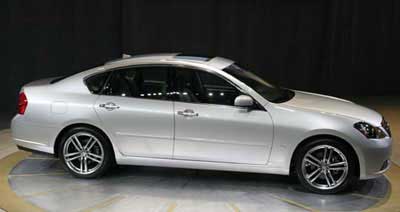
2005 Porsche 911 Carrera/Carrera S Cabriolet
Over the past few weeks, there have been so many new, updated, redesigned, concept, and special-packaged vehicles unveiled to the public that it honestly becomes difficult to keep track. At the Los Angeles and detroit auto shows, it's been electric convertibles here, double-engine SUVs there, and everything in between. Yet, with all of the brands and their respective offerings, it comes down to one very simple principle: choices for the consumer. And lots of them. If all drivers simply wanted to go fast, there would be one dominant fast car, and for hauling cargo, there would be one main truck. But buyers want choices with a variety of designs, options, colors, sizes, and to some degree, heritage and status. And that's where the 2005 North American International Auto Show debut of the 2005 Porsche 911 Carrera Cabriolet comes into play. Porsche offers this model in two trims, 911 Carrera Cabriolet and 911 Carrera S Cabriolet. The 2005 Porsche 911 Carrera Cabriolet is priced at $79,100 while the 2005 Porsche Carrera S Cabriolet rings up at $88,900 (prices exclude destination charges). Both models come with a long list of standard features including a soft convertible top with rear glass, rear defroster, and rear wind deflector; an electric air compressor and tire sealant in place of the traditional spare; automatic climate control; six airbags including dual front, dual side, and dual head protection airbags that pop out of the door sills; alloy wheels (18-inch on the 911 Carrera Cabriolet and 19-inch on the 911 Carrera S Cabriolet) automatic roll bars that are activated by rollover sensors; front cross-drilled and ventilated disc brakes and rear disc brakes; rigid body structures; and the Porsche Stability Management safety system. Updated for 2005, Porsche Stability Management now allows drivers more control over the system. In the past, the system was activated whenever the brake pedal was depressed (even if the driver had turned the system off). However, on the 2005 911 Carrera Cabriolet the Stability Management system will only be activated after the threshold of one of the front ABS sensors has been passed (when the system is turned off). This allows the driver more control at the limits and makes the safety technology less intrusive. Along that same vein is the optional Sport Chrono Package Plus. This package includes a stopwatch, lap counter, and a graphic display. For vehicles equipped with the Tiptronic transmission, the Chrono package switches the transmission to manual mode, but should the driver not upshift, the transmission will eventually change gears, albeit much more aggressively for improved acceleration. Also, the stability control system is setup to allow more tire spin when the Chrono package is activated, and the ABS is set to be less intrusive. This package promises to put some of the fun back into extreme driving. Powering the 2005 Porsche 911 Carrera Cabriolet is a 3.6-liter, 325-horsepower boxer engine that generates 273 lb.-ft. of torque. The 2005 Porsche Carrera S Cabriolet is powered by a 3.8-liter, 355-horsepower boxer engine that twists out 295 lb.-ft. of torque. Standard is a six-speed manual transmission, with the Tiptronic auto being optional. Handling that power is the job of an independent MacPherson front suspension and an independent five-arm setup in the rear. All models are equipped with front and rear stabilizer bars, and the S model comes standard with Porsche's Active Suspension Management system. Most importantly is that this is all available in a convertible. The power soft-top system on the 2005 911 Carrera Cabriolet is a mere 93 pounds, and can be operated at speeds up to 31 mph. While stopped, the top can be raised and lowered in 20 seconds; while traveling up to 31 mph, raising and lowering the top takes 26 seconds. One of the benefits of the lightweight top is that it helps provide a low center of gravity. As expected, the convertible weighs a bit more than the coupe (about 188 pounds), but performance has hardly suffered. Zero to sixty times are a hair slower for the convertible (five seconds for the 911 Carrera Cabriolet and 4.7 seconds for the 911 Carrera S Cabriolet), but top speeds are the same (177 mph for the 911 Carrera Cabriolet and 182 mph for the 2005 Porsche Carrera S Cabriolet). Porsche has offered up an impressive driver's car in the 2005 911 Carrera Cabriolet. There are faster, less expensive (and more expensive) cars for shoppers to buy, but it all comes back to choices. And as Tom Cruise wisely once said, "Porsche. There is no substitute." By Thom Blackett
Photos by Erik Hanson
